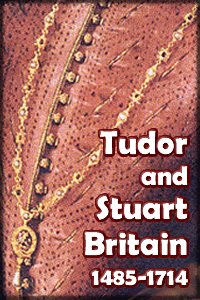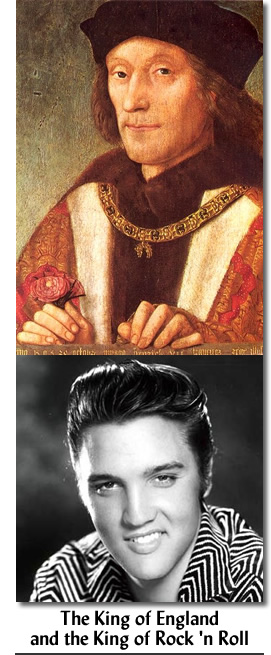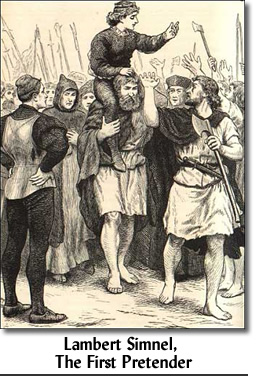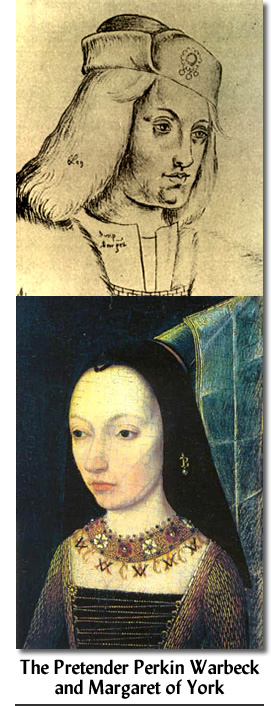

Henry VII
and the
Pretenders
Simnel and Warbeck
Served as Pawns
For
Yorkist Plotters.

By Ronald Fritze
Posted on September 12, 2011, from Athens, Alabama

Oh yes, I'm the great pretender
Just laughing and gay like a clown
I seem to be what I'm not you see
I'm wearing my heart like a crown
The Platters

We don’t use the term “pretender” in American political discourse very much and we definitely don’t use it in the sense that people living under a system of hereditary monarchy used the term. In the monarchial governments of the past, a pretender was someone who aspired to an office or the throne, usually under false pretenses.
Under a system of hereditary monarchy, power normally was passed on as an inheritance to a son or some other member of the family of the ruling dynasty. Occasionally someone would seize the throne through force, which is exactly what Henry VII did to gain the English throne in 1485. But whenever people made such power grabs, they quickly attempted to justify their actions through some sort of appeal to hereditary succession.
In Henry VII’s case, he did that by appealing to his Lancastrian roots and his descent from Edward III, which he bolstered by marrying Elizabeth of York, the eldest daughter of the deceased Edward IV. But he still faced challenges from Yorkist claimants. Adding to Henry VII’s problems with challengers was the appearance of a couple of impostors who claimed to be important members of the York dynasty with strong claims to the throne.
Now you might ask, didn’t anyone realize that these two pretenders were not the people whom they claimed to be? Yes, some members of the York family and their close associates were in a good position to know that these two young men were fakes. But to Yorkist plotters, the facts didn’t matter, and they encouraged the impostors in the hope of overthrowing the hated Henry VII.
Without Photos or TV Talking Heads,
What's an Englishman to Believe?
Otherwise, most people of that era never got a close look at their rulers. Londoners had greater opportunities to see monarchs, but in large parts of the realm, the common people never saw their king and his family in the flesh. They also did not see photographs of
 monarchs or get to watch them on television. Those kinds of ready popular imagery lay over 400 years in the future.
monarchs or get to watch them on television. Those kinds of ready popular imagery lay over 400 years in the future.
So, anybody who showed up looking and acting sufficiently royal would have been given credence. If you looked like a king, dressed like a king, and acted like a king, you must be a king. The English were not alone in granting some credibility to impostors claiming the throne. The phenomenon of pretenders was even more common and more successful in seventeenth-century Russia. It has occurred throughout history in many parts of the globe.
Keep in mind, impostors pretending to a throne also benefit from people wanting to believe. Many people in my lifetime were reluctant to accept the finality of pop music king Elvis Presley’s death, giving rise to frequent reports of Elvis sightings for many years after his demise -- a situation most likely aggravated by the proliferation of Elvis imitators. The same phenomenon occurred after the death of the singer Jim Morrison, although (so far) I have heard no reports of Michael Jackson sightings.
From King Sebastian to President Kennedy. . . .
When someone famous or important dies prematurely, a spirit of anxious denial is sure to arise. Stories circulated almost immediately that President John F. Kennedy had not died from his wounds at Dallas. These stories represent societal delusions with deep roots. For example, when King Sebastian of Portugal died at the Battle of Al Kazar al Kebir, rumors of his survival and claims of sightings followed in Portugal for several years. The delusion even had a name, Sebastianismo. Another case involved Edward VI of England, who death as a young man in 1553 led to tales that he had not really died.
These kinds of rumors were often tinged with political undertones and sinister motives. The people who supported Henry VII’s rival pretenders didn’t float false rumors of Richard III’s survival, but all the same they were the kind of people who wanted to believe. They disliked Henry VII with passionate intensity and wanted the dynasty of York restored to the throne. That made it easy for an impostor to fool them into accepting a false heir.
Raising Up the First Pretender
The first pretender to appear during the reign of Henry VII was
 named Lambert Simnel, who came on the scene in 1486 and 1487. Simnel was a ten-year-old boy, the humble son of a tradesman. Nevertheless, an ambitious priest named Richard Symonds concluded that Lambert would make a good fake Yorkist heir to the throne.
named Lambert Simnel, who came on the scene in 1486 and 1487. Simnel was a ten-year-old boy, the humble son of a tradesman. Nevertheless, an ambitious priest named Richard Symonds concluded that Lambert would make a good fake Yorkist heir to the throne.
Sir Francis Bacon, over a century later in his The History of the Reign of King Henry the Seventh, described Simnel as “a comely youth, and well favoured, not without some extraordinary dignity and grace of aspect.” Other members of the Yorkist family decided to support Simnel. Bacon asserted that Elizabeth Woodville, the queen dowager, was one of Simnel’s backers, but his true promoter were a pair of determined plotters: John de le Pole, the Earl of Lincoln, and Margaret of Burgundy, the sister of the last Yorkist kings Edward IV and Richard III.
According to Bacon, the initial plan was to have Simnel impersonate Richard, the Duke of York, the second son of Edward IV. But the conspirators changed their minds and instead assigned to Simnel the role of Edward, Earl of Warwick and nephew of Edward IV. The plan became problematic because Henry VII held the true Earl of Warwick in the Tower of London. When the threat from Lambert Simnel became serious, the king brought the real Earl of Warwick out of captivity and displayed him to Londoners to show that Simnel was a fake.
The Irish Were Determined to Believe,
And Then to Fight! (They Lost.)
The gesture convinced most Londoners, but over in Ireland, amidst a hotbed of pro-Yorkist sentiment, the actual Earl’s presence made no difference. According to Sir Francis Bacon, the Irish “turned the imposture upon the King [Henry VII]; and gave out that the King, to defeat the true inheritor, and to mock the world and blind the eyes of simple men, had tricked up a boy in the likeness of Edward Plantagenet [the Earl of Warwick], and shewed him to the people.” Accordingly the Irish nobles and clergy crowned Simnel as their king in Dublin Cathedral.
Soon thereafter an invasion of England took place, but it garnered little support from the English people. The resilient Henry VII gathered his army and defeated the Irish invaders at the Battle of Stoke on 16 June 1487. The conspirator Lincoln died in the battle and Simnel was taken prisoner. The magnanimous Henry VII released the young pretender and gave him a job as a turnspit in the royal kitchens. Simnel later graduated to serving as one of the king’s falconers.
The Male Model Who Wanted to Be King
The second threat from a pretender occurred several years
 later, beginning in 1491 and lasting until 1499. This pretender’s name was Perkin Warbeck, who was born in the Low Countries in 1475. An attractive child, he secured a job modeling expensive clothes with an upscale clothier named Pregent Meno. Yes, that’s right. He was a male model!
later, beginning in 1491 and lasting until 1499. This pretender’s name was Perkin Warbeck, who was born in the Low Countries in 1475. An attractive child, he secured a job modeling expensive clothes with an upscale clothier named Pregent Meno. Yes, that’s right. He was a male model!
More importantly, Warbeck came to the attention of some of the perennial Yorkist plotters. According the Sir Francis Bacon, Margaret, the Duchess of Burgundy and the sister of Edward IV and Richard III, had been on the lookout for potential candidates to impersonate the disappeared Princes in the Tower. She despised Henry VII and wanted to topple him from his newly acquired throne. Having the vast resources of the Duchy of Burgundy at her disposal, she was in a good position to give Henry VII serious problems. Her implacable animosity was so intense that Henry VII’s courtiers referred to her as the goddess Juno to Henry VII’s Aeneas.
Soon after Margaret’s agents spotted Warbeck, she recruited him and groomed him as the impostor Richard, the Duke of York. She kept her role secret so as to bolster Warbeck’s supposed bona fides. Bacon described Warbeck’s four assets in this way:
“For first, the years agreed well [i.e., he was the right age]. Secondly, he was a youth of fine favour and shape; but more than that, he had such a crafty and bewitching fashion both to move pity and to induce belief, as was like a kind of fascination and inchantment to those that saw him or heard him. Thirdly, he had from his childhood been such a wanderer, or (as the King called it) was a landloper, as it was extreme hard to hunt out his nest and parents; neither again could any man, by company or conversing with him, be able to say or detect well what he was; he did so flit from place to place. Lastly, there was a circumstance (which was mentioned by one that writ in the same time) that is very likely to have made somewhat to the matter; which is, that King Edward the Fourth was his godfather. Which, as it is somewhat suspicious for a wanton prince to become gossip [i.e., be a godfather] in so mean a house [i.e., Warbeck came from a family of commoners], and might make a man think that he [Warbeck] might indeed have in him some base [illegitimate] blood of the house of York.”
Warbeck was a much better impostor than Simnel. In the judgment of Sir Francis Bacon, Warbeck:
“was a finer counterfeit stone than Lambert Symnell; better done, and worn upon greater hands; being graced after with the wearing of a King of France and a King of Scotland, not of a Duchess of Burgundy only. And for Symnell, there was not much in him, more than that he was a handsome boy, and did not shame his robes. But this youth (of whom we are now to speak) was such a mercurial, as the like hath seldom been known; and could make his own part, if any time he chanced to be out. Wherefore this being one of the strangest examples of a personation, that ever was in elder or later times.”
As Bacon alludes, Margaret of Burgundy was not the only powerful player to promote the cause of Perkin Warbeck. For a period of time he was supported by both Charles VIII of France and James IV of Scotland along with the usual Irish malcontents. Both the French and the Scottish king used Warbeck for their own purposes during their wars with Henry VII. James IV even took Warbeck along on an invasion of northern England that was supposed to be a prelude to placing him on the throne.
Warbeck Falls into the Hands
of a Magnanimous Regent.
Political expediency eventually led both kings to cut Warbeck loose to satisfy a much desired agreement with Henry VII. But neither man turned the pretender over to the English king as Henry VII requested. James IV even allowed Warbeck to marry one of his cousins, Lady Catherine Gordon. Ultimately, Warbeck unwisely attempted his own invasion of England in the West Country. He failed to capture Exeter. Royal forces cut off his escape and he was forced to surrender.
Once again Henry VII tried to be generous to the failed pretender. Lady Catherine Gordon, who had accompanied Warbeck on his invasion, was appointed as a lady-in-waiting to Queen Elizabeth of York. Warbeck was kept under a loose house arrest at Westminster Palace, but he tried to escape in June 1498. From that point, he was imprisoned in the Tower of London with his supposed cousin, the real Edward Plantagenet, Earl of Warwick.
Finally, an Execution and Regal Remorse
Unfortunately for both young men, Henry VII was negotiating for the marriage of his son Arthur to Catherine, the daughter of Ferdinand and Isabel of Spain. The Spanish monarchs informed Henry VII that no deal could be finalized as long as potential Yorkist rivals remained to threaten the new Tudor dynasty. They wanted both Warbeck and Warwick eliminated. Henry VII obliged. His agents lured the two prisoners into making an escape attempt. They were caught and promptly tried for treason and executed.
Thus ended the last great Yorkist plot against Henry VII. True, the king had managed to secure the crown for his family, but the security came at a psychic price. Contemporaries speculated that although Henry won the political struggle, he failed to secure a clean conscience. Contemporaries claimed that he quickly aged twenty years in the wake of the judicial murder of Warwick and Warbeck.
“But, sirrah, ran there in thy veins one drop Of such a royal blood as flows in mine, Thou wouldst not change condition, to be second In England's state, without the crown itself. Coarse creatures are incapable of excellence : But let the world, as all to whom I am This day a spectacle, to time deliver, And by tradition fix posterity .—-—Without another chronicle than truth, How constantly my resolution suffer'd martyrdom of majesty.”
— Perkin Warbeck to Lambert Simnel during their fictional meeting in the Tower of London as imagined by John Ford’s (c1586-c1637) play, Perkin Warbeck (written c1629-1634)

To read Dr. Fritze's previous Tudor and Stuart Britain essay, Good to Be King? Give Henry VII His Proper Due as Tudor Founder, click the reading glasses above.

|